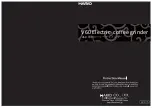
ENGLISH
55
NOTE:
If the gear case and motor housing become
separated by more than 6.35 mm (1/4"), the tool
must be serviced and re-assembled by a D
E
WALT
service centre. Failure to have the tool serviced may
cause brush, motor and bearing failure.
3. Re-install screws to attach the gear case to
the motor housing. Tighten screws to 2.08 Nm
(18 in-lbs.) torque. Overtightening could cause
screws to strip.
Mounting and Removing the Guard
(fi g. 4)
WARNING:
To reduce the risk of
serious personal injury, turn tool off and
remove battery pack before making
any adjustments or removing/installing
attachments or accessories
.
CAUTION: Guards must be used
with all grinding wheels, cutting
wheels, sanding flap discs, wire
brushes, and wire wheels.
The tool
may be used without a guard only
when sanding with conventional
sanding discs. The DC413/DC415 is
provided with a guard intended for use
with depressed centre wheels (Type 27)
and hubbed grinding wheels (Type 27).
The same guard is designed for use
with sanding flap discs (Type 27 and 29)
and wire cup brushes.
CAUTION:
Guards must be used with
this grinder.
When using the DC413 or the DC415 grinder with a
bonded abrasive wheel for cutting metal or masonry
a Type 1 guard MUST be used. Type 1 guards are
available at extra cost from D
E
WALT distributors.
NOTE:
Please refer to the
Grinding and Cutting
Accessory Chart
at the end of this section to
show other accessories that can be used with these
grinders.
1. Open the guard latch (n), and align the lugs (p)
on the guard with the slots (o) on the gear case.
2. Push the guard down until the guard lugs
engage and rotate freely in the groove on the
gear case hub.
3. With the guard latch open, rotate the guard (h)
into the desired working position. The guard
body should be positioned between the spindle
and the operator to provide maximum operator
protection.
4. Close the guard latch to secure the guard on
the gear case. You should not be able to rotate
the guard by hand when the latch is closed. Do
not operate the grinder with a loose guard or
the clamp lever in open position.
5. To remove the guard, open the guard latch,
rotate the guard so that the lugs are aligned
with the slots and pull up on the guard.
NOTE:
The guard is pre-adjusted to the diameter of
the gear case hub at the factory. If, after a period of
time, the guard becomes loose, tighten the adjusting
screw (q) with clamp lever in the closed position with
guard installed on the tool.
CAUTION:
If the guard cannot be
tightened by the adjusting clamp, do
not use the tool. To reduce the risk of
personal injury, take the tool and guard
to a service centre to repair or replace
the guard.
NOTICE:
To reduce the risk of damage
to the tool, do not tighten the adjusting
screw with the clamp lever in the open
position. Undetectable damage to the
guard or the mounting hub may result.
NOTE:
Edge grinding and cutting can be performed
with Type 27 wheels designed and specified for this
purpose; 6.35 mm (1/4") thick wheels are designed
for surface grinding while 3.17 mm (1/8") wheels are
designed for edge grinding.
Prior to Operation
• Install the guard and appropriate disc or wheel.
Do not use excessively worn discs or wheels.
• Do not use a damaged accessory. Before each
use inspect the accessory such as abrasive
wheels for chips and cracks, backing pad for
cracks, tear or excess wear, wire brush for loose
or cracked wires. If power tool or accessory
is dropped, inspect for damage or install an
undamaged accessory. After inspecting and
installing an accessory, position yourself and
bystanders away from the plane of the rotating
accessory and run the power tool at maximum
no-load speed for one minute. Damaged
accessories will normally break apart during this
test time.
• Be sure the inner and outer flange are mounted
correctly. Follow the instructions given in the
Grinding and Cutting Accessory Chart
.
• Make sure the disc or wheel rotates in the
direction of the arrows on the accessory and
the tool.
















































